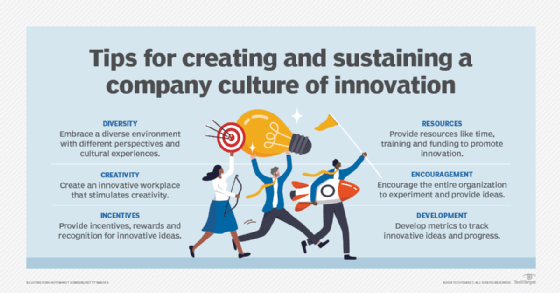innovation culture
What is an innovation culture?
Innovation culture is the work environment that leaders cultivate to nurture unorthodox thinking and its application. Workplaces that foster a culture of innovation generally subscribe to the belief that innovation isn't the province of top leadership but can come from anyone within the organization. Innovation cultures are prized by organizations that compete in markets defined by rapid change. Maintaining the status quo is insufficient to compete effectively, thus making an innovation culture essential for success.
Innovation cultures often measure employees based on metrics such as value creation for customers and shareholders as well as competitive differentiation instead of traditional metrics such as on-time delivery and revenue generation. Companies that foster innovative thinking also encourage discovery and find ways to reward time spent on the research required to generate new products and ideas. A much-cited example of this is Google's "20% time" policy, which allows employees to spend one-fifth of their work week on what they want to work on, with the expectation that this discretionary work will result in an innovation.
What makes a culture innovative?
The following key concepts must be present in a company culture to make it innovative:
- Capacity for innovation. An innovative company culture requires the presence of leaders, from the C-suite down, who are innovators themselves and a growing number of employees who either share that capacity for innovation or develop it through training and continuous learning. Cultivating innovation by encouraging brainstorming and empowering team members to be problem solvers is essential to building that capacity.
- Desire to innovate. Organizational cultures change when their members desire that change. Leadership can stimulate that desire through empowering employees, championing innovation as an institutional value, modeling risk-taking and establishing communication channels dedicated to new ideas.
- Opportunity. Identifying opportunities for innovation can stimulate its proliferation in the enterprise. This includes cultivating resources and making them readily available; creating spaces, from workspaces to laboratories, where innovation can be explored; and actively promoting cooperative efforts between teams.
Another essential is adopting diversity as a cornerstone. Bringing together team members with differing backgrounds, skill sets and perspectives is essential to the growth of effective innovation teams. The organizational culture should double down on diversity as an institutional value in pursuit of ground-breaking new ideas.
Why is an innovation culture important?
Innovation cultures are difficult to establish and sustain but are considered by many management experts as essential for creating competitive differentiation and competitive advantage in the marketplace. Another benefit of creating a culture of innovation is staff retention.
When it comes to IT innovation, it's important that IT leaders understand that a culture of innovation isn't just about the big idea or creating a think tank. Creating an innovation culture requires hard work, including establishing new measurements, inventing and accepting new job roles, knowing how to monetize innovation, and understanding what failure looks like.
Failure occurs when innovators don't ask enough questions, when concepts aren't workable, when plans are deemed too costly or when systems crash. But that isn't to say that failure is bad. Many cultures reject failure, but experts agree that failure can be a natural part of the learning process. As Albert Einstein once said, "Failure is success in progress."
Examples of innovative company cultures
Many prominent companies have supported innovation cultures with spectacular results. Historically, this includes Apple and Microsoft, which pioneered personal computing; Amazon, which redefined retail; Google, which opened the internet to new possibilities with search functionality; and Facebook and Twitter, which brought about massive societal change through social media.
Pixar is noteworthy for revolutionizing both the field of animation and the movie industry itself. Tesla has taken great strides toward realizing electric vehicles and clean energy. OpenAI brought artificial intelligence into the workaday realm for office employees, students and home use with its generative AI progress.
How can an organization create an innovative company culture?
IT organizations can create an innovation culture by doing the following:
- Embracing digital. Innovation is par for the course with companies that aim to make the shift from traditional to digitalized business processes. Going digital is often the first step toward creating an innovation culture that permeates the workplace rather than resides solely in IT or other departments. Examples of digital projects include mobile payment and mobile product recommendations initiatives as well as any real-time network data provisioning. Each requires innovation. Until a few years ago, these projects were impractical and cost prohibitive.
- Establishing an innovation lab. Creating an innovation lab serves many purposes, but one byproduct of such labs is a renewed collaboration between IT and the business. Business innovation is closely tied today to information technologies. Large companies like Amazon and IBM are well-known for their innovation labs, but smaller companies and startups aren't always recognized for their advances.
- Enabling experimentation. An innovation culture lets people experiment. For instance, an IT organization crawling through historical data, with no specific questions in mind, might uncover findings that were totally unexpected based on correlations in the data. Nascent big data and improved higher-performance analytics engines are making data discovery -- exercises that were previously too time-consuming or cost-prohibitive for most companies -- now practical.

How can an organization sustain innovation?
Establishing a culture of innovation is one thing; sustaining that culture is another. Companies can sustain a culture of innovation by doing the following:
- Rewarding employees for innovative efforts. One way IT organizations can sustain a creative, exploratory culture is by rewarding employees for this kind of work. Another way to maintain innovative thinking is by exploring different corporate culture models like holacracy.
- Changing the reward and measurement structure. There are traditional measurements that require a person is on time with projects, but those measurements aren't as important in an innovation culture. Instead, organizations with innovation cultures are measuring success by asking what business value the person has delivered, how sustainable that value has been, what new ideas they've brought to the table and how many of these ideas were executed.
- Exploring alternative management structures. Organizations have many management structures to consider, each having unique benefits and drawbacks. For example, a flat leadership style lets teams explore ideas and take ownership of their projects. Another approach is a holacracy, which is a governance structure that distributes power among self-organizing groups, rather than being vested in a typical hierarchical corporate culture model. One architect and early adopter of the holacracy structure is Zappos. It found that forming a flat organization creates a whole new employee network of relationships across organizational silos as well as aims to make things happen more quickly and dynamically than in traditional top-down structures.
Startups must not only survive but also thrive to stay ahead of their competition. Learn what tech entrepreneurs must do to ensure their companies succeed.






